
© Railway Wonders of the World 2012-


By Rail in the Argentine
A Republic That Has 23,000 Miles of Track
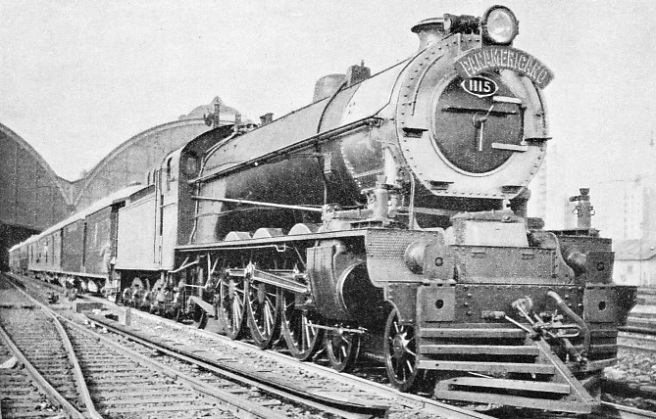
OVER FORTY-
THE great Republic of Argentina is served by over 23,000 miles of railways, and many of its lines have been built by British companies which have spent hundreds of millions of pounds on them. Argentina is situated in the south of South America, being bounded on the north by Bolivia and Paraguay, on the north-
Buenos Aires, the capital, has over 2,200,000 inhabitants, and is the largest city in the southern hemisphere and one of the largest in the world. It is a great port, situated on the wide Rio de la Plata (River Plate), and is the gate through which most people and goods pass into and out of the country. The city is the centre of a network of railways that are the most important in South America. The railways have helped considerably to develop Argentina and Buenos Aires.
The termini of three British-
The Central Argentine system represents the fusion since 1870 of a number of lines, the last and most important amal-
The main trunk line runs northward for over 700 miles through the provinces of Buenos Aires, Santa Fe, Santiago del Estero and Tucuman. The fertile and picturesque province of Cordoba, in the west, is traversed by a number of branches running more or less parallel and converging on the cities of Cordoba and Rio Cuarto. The railway thus traverses five provinces, and runs through the heart of the grain belt, from which the bulk of the company’s traffic and revenue is derived.
Outside Buenos Aires the railway serves the principal cities in the central and northern zones of the Republic, including Rosario, Santa Fe, Cordoba, Santiago del Estero, Tucuman, and Rio Cuarto, in addition to the river ports of San Nicolas, Villa Constitucion, Zarate, San Pedro and Baradero, all of which are situated within the Central Argentine zone of influence.
Rosario, with 500,000 inhabitants, is the second city in Argentina in population and commercial importance. Next to Montreal it is the largest grain-
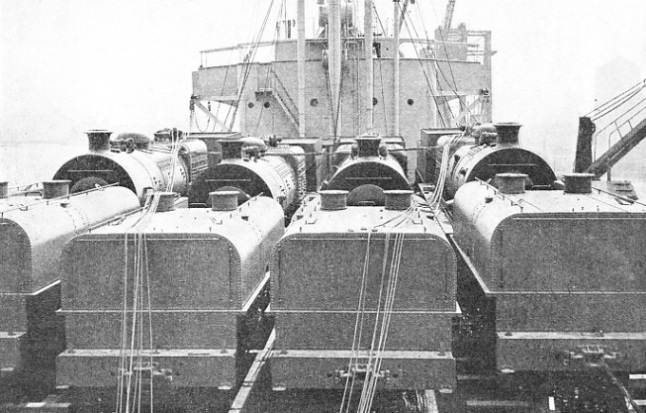
LOCOMOTIVES ON DECK. In 1929 ten “Beyer-
The importance of Rosario as a port and railway centre is enhanced by the fact that it is the headquarters of the Central Argentine Carriage and Wagon Works, occupying about seventy-
The main line from Rosario to Tucuman, opened in 1891, serves rich sugar plantations, to which this province owes its commercial importance; and a short branch from La Banda -
Spiked Rails
Rio Cuarto, in the south-
Cordoba, with a population of 300,000, is the chief city of the central provinces. Here connexion is made with the Central North Argentine (State) line, serving a number of picturesque holiday resorts in the higher hills, as well as to the provinces of Catamarca, Rioja, and San Juan. At Tucuman, another important connexion is effected with the State Railways for the provinces of Salta and Jujuy and the international service to Bolivia and Peru.
Of the 3,700 miles of line which compose the system 319 miles are double, two miles quadruple and the remainder single track. In general, the tracks are laid with 85-
The signalling conforms generally to British practice and varies in accordance with the type and volume of traffic on the different sections. On the Buenos Aires electrified suburban section are to be found power-
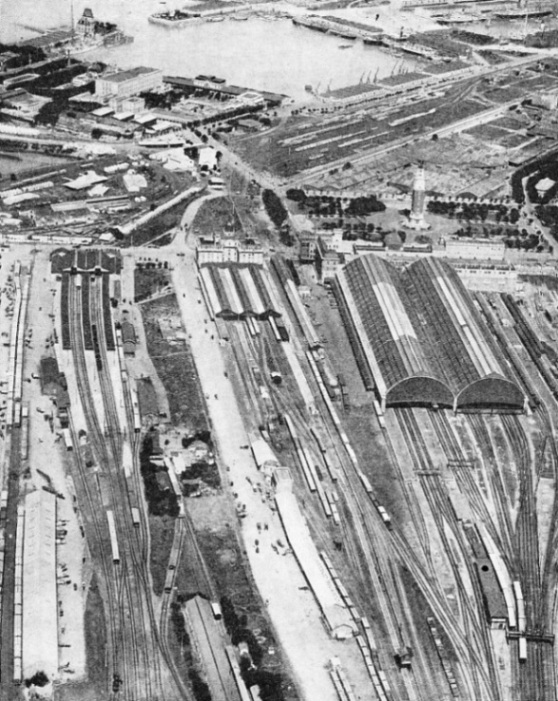
AT BUENOS AIRES. This remarkable aerial view shows the termini of three big systems. The double-
The rolling stock consists of 675 locomotives, 1,227 coaches and 18,371 wagons. All the locomotives, goods and passenger types, are modern, thus enabling a uniformly high rate of speed to be maintained by the long-
At present passenger traffic on the Railway is about 43,000,000 passengers a year, of which 37,000,000 correspond to the Buenos Aires suburban area. Goods traffic amounts to some 8,000,000 tons a year, and in the course of a year about a million head of cattle, horses, sheep and pigs are conveyed over the system. Among the principal items of goods traffic are maize, the volume of which fluctuates around 3,000,000 tons annually; wheat, 2,000,000 tons, and linseed, 500,000 tons. Flour, charcoal, wine, firewood, potatoes, petroleum, and general merchandise are other valuable sources of revenue to the company. The public traffic train mileage reaches 12,250,000 miles a year, of which 2,750,000 miles correspond to electric suburban trains, 5,750,000 miles to steam-
Expresses of 650 Tons
The average gross load behind a goods engine is in the neighbourhood of 870 tons, although over certain sections the most powerful locomotives are capable of hauling over 2,000 tons, distributed between paying load and tare weight. The average load behind a passenger engine amounts to 284 tons, but the most important expresses hauled by P.S.11 type loco-
The Central Argentine Railway operates the fastest train in South America. This is the daily express between Buenos Aires and Rosario and vice-
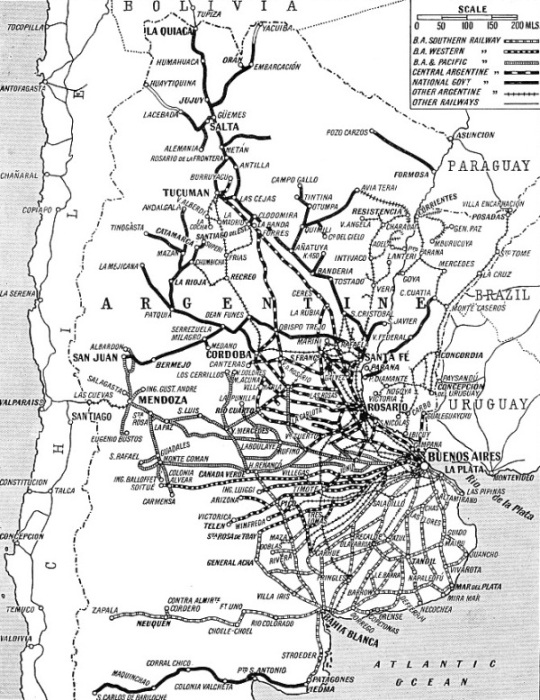
THE CHIEF ROUTES of the several railway systems in the Argentine Republic are indicated on this map. There are 23,704 miles of line open, of which 5,764 are controlled by the State. The first railway in the Argentine was opened to traffic in 1857. The normal gauge of the Argentine Railways is the Spanish one of 5 ft 6 in, but standard and narrow gauges are also to be found in this country.
The Central Argentine was the first South American railway to electrify its suburban lines. The first section, about eighteen miles long, has been electrically operated since August, 1916. The two remaining sections, comprising about twenty-
The suburbs served by the company are among the most attractive around Buenos Aires. The policy of electrification has added to the popularity of these places as residential centres and pleasure resorts, many of them having athletic clubs. The best-
Retiro, the Buenos Aires terminus of the Railway, was opened in August, 1915. It is the largest and finest terminal station south of the equator. The area occupied by the buildings and train sheds, including approaches, is about 744,000 sq ft, with a main frontage facing Calle Maipu of 850 ft, and a side frontage along Avenida Leandro N, Alem of 606 ft. The booking hall is 200 ft in length, 60 ft wide, and 65 ft high. There are eight platforms, those for the main-
There are two other handsome stations at Cordoba (opened in 1919) and Campana (opened in 1925). Campana Station is on the main line to Rosario and serves a small town and river port, near to which are large petroleum refineries.
Route to the USA
As far as Tucuman the Central Argentine Railway forms the first section of the northern transcontinental route known as La Diagonal de Hierro (“The Iron Diagonal”), which comprises six railway systems and runs from Buenos Aires through northern Argentina, Bolivia, and Peru to the Pacific port of Mollendo, and combines with the Antofagasta and Bolivia Railway for the Chilian port of Antofagasta. This transcontinental line offers an alternative and greatly shortened route to and from the United States via the Panama Canal and the West Indies, and, being free from interruption by snowstorms, is available all the year round.
Consisting for the most part of a vast alluvial plain devoted mainly to pasturage and agriculture, the zone served by the railway lacks the spectacular grandeur to be found in other parts of South America, but two exceptions to this are the Cordoba hills and the province of Tucuman.
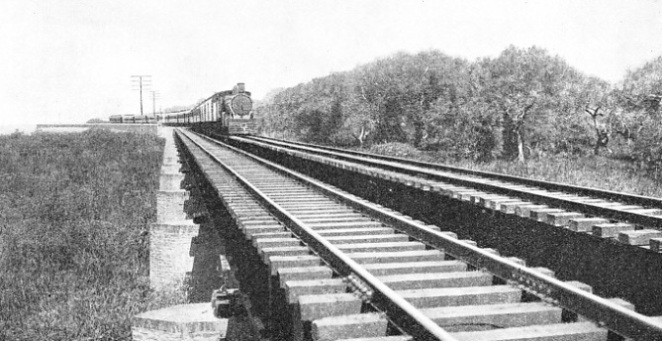
2,500 SLEEPERS A MILE are laid along the lines of the Cordoba Central Railway. The railway is metre-
The Cordoba hills combine a delightful climate with some of the most picturesque scenery in the Argentine, and their popularity among holiday-
The principal beauty spots are Alta Gracia (connected with the city of Cordoba by a branch line); La Falda, La Cumbre, Los Cocos, San Esteban, Capilla del Monte, and Cruz del Eje (all on the State Railway); and Mina Clavero (connected with Cordoba by an omnibus service). At all these places there are good hotels with facilities for lawn tennis, swimming, riding, driving, and motoring. There are golf courses at Alta Gracia, La Cumbre, La Falda, Ascochinga, and Villa Allende.
Tucuman is one of the most important points on the railway. It is the headquarters of the national sugar-
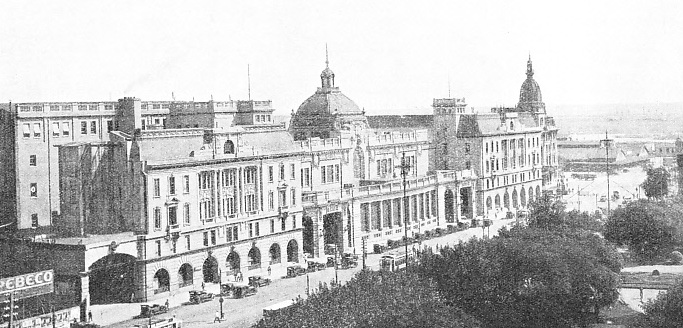
THE RETIRO TERMINUS of the Central Argentine Railway at Buenos Aires has eight platforms, those for the main line being 1,148 ft long, and the others 820 ft in length. The booking hall is 200 ft in length, 60 ft wide and 65 ft in height. The Central Argentine Railway in the suburban area round Buenos Aires carries some 37 million passengers annually.
In the province of Santiago del Estero the railway traverses a zone naturally arid and unproductive. But by a means of dry farming, introduced by the company in 1913 and adapted to the nature of the soil and local climatic conditions, abundant crops, fruit and vegetables of many species and excellent quality, as well as cotton, are successfully cultivated. Practical instruction, and educative propaganda by similar methods carried on among the farming community have given an impetus to agriculture and fruit-
Active propaganda, cheap tares, and excursion trains have popularized the holiday resorts, and the railway has stimulated passenger traffic from the provinces to the capital by the same methods.
The Buenos Aires and Pacific Railway was founded in London in 1882 to acquire from John E. Clark part of a contract he had made with the Argentine Government in 1874 for the construction of two rail ways. One of these was to run between Buenos Aires and San Juan, passing through Rojas or Junin, Villa Mercedes, San Luis, La Paz, and Mendoza. The other was to run from Mendoza or San Juan, in the direction of San Felipe de los Andes (Chile) up to the limit of the Argentine Republic, either by the Los Patos Pass, or by the Uspallata Pass.
The original contract was for a metre-
The first passenger train made the journey from Mercedes to Villa Mercedes, 359 miles, on October 15, 1886 It was about 165 ft. long, and had neither restaurant nor sleeping cars; trains are now as long as 1,300 ft. The return journey was made with the same engine and crew, the driver being Mr Alfred Marsh, and the fireman Mr. Patrick Wynne. Mr. Wynne became superintendent of the traction department of the Railway, and retired in 1928.
A Stormy Career
The section of the line eastward from Mercedes to Palermo, in the city of Buenos Aires, was opened in 1888, and at that time the company used the tracks of the Central Argentine inwards from Palermo to the heart of the city, the Central station of the Central Argentine then being near the Government House. It was not until July, 1912, that the Pacific was able to run its trains into the present terminus at Retiro, close to the docks and alongside the port works.
The early history of the railway was chequered. Construction from the two extremities, Mercedes and Villa Mercedes, instead of from Buenos Aires, meant that materials had to be carried over the Western Railway to Mercedes, or from Rosario, via the Andine Railway, to Villa Mercedes. The Western Railway could not cope with its own traffic and the Andine Railway refused to carry the materials. But when Mr. Clark hired bullock carts for the transport to railhead, the Andine Railway, which had regarded the Pacific as a future competitor, realized that resistance was useless, and allowed the materials to go over its line.

THE CORDOBA-
In 1886-
Retiro, where the terminal stations of the three railways are now situated, was the name of a district the centre of which was a slave market in Spanish colonial days. An area of about 300 acres was acquired outside the city boundary, between Deveto and Caseros, for erecting running sheds, workshops, and sorting sidings. In 1907 the section from Junin to Villa Mercedes, 270 miles, was relaid with 100-

“MIKADO” ENGINE series 3001/8 for operation on the Buenos Aires and Pacific Railway. The engine weighs 102½ tons when empty, and 114½ tons in working order. The tender holds 7,700 gallons of water and 15 tons of coal, and weighs, in working order, some 86½ tons. This
2-
The terminus and goods yard at Retiro occupy no acres, and the high-
Construction Dangers
From Palermo the line traverses a densely populated area to the city boundaries, ten miles from Retiro Station. The local section extends to Jose C. Paz (named after the founder of the newspaper La Prensa), twenty -
One of the longest stretches of dead straight and dead level track in the world extends for 205½ miles from west of Junin to west of Mackenna. Although most of the country traversed by the railway is flat, hilly country is encountered beyond Villa Mercedes in the direction of San Luis and Mendoza, to the north-
During its passage westward across Argentina the Pacific runs through different zones. For the first hundred miles out of Buenos Aires the tine passes through pasture lands devoted to dairy farming, market gardening, and hay production. Farther west, large tracts are under cereals, maize predominating in the eastern and more humid zone, and wheat in the central districts. Along the whole route a large part of the country is devoted to cattle. After Justo Daract, 407 miles from Buenos Aires, scrub predominates for 170 miles; but cereals have been grown successfully as far west as San Luis. At La Paz the appearance of the country changes, for here the line reaches the beginning of the irrigated zone of the province of Mendoza.
There are few large towns on the Pacific Railway. Mendoza, with a population of 78,000, is the largest city on the line after Buenos Aires, Junin, 33,000, where the railway workshops
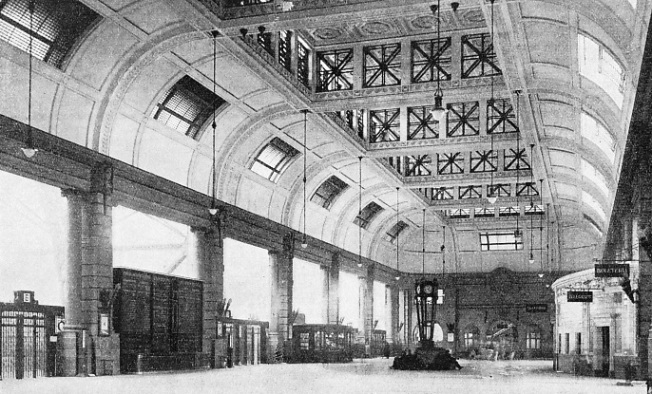
THE GRAND HALL of the Retiro Terminus of the Central Argentine Railway at Buenos Aires. This Grand Hall or concourse is 480 ft in length 82 ft in width, and 63 ft in height. Of lofty and spacious design the station buildings at Retiro rank among the best in the world.
There are few large towns on the Pacific Railway. Mendoza, with a population of 78,000, is the largest city on the line after Buenos Aires, Junin, 33,000, where the railway workshops are situated, being next. The most distant termini are Albardon (785 miles), Marquesado (763 miles), San Juan (757 miles), and Eugenio Bustos (729 miles).
During the construction of the line there were many adventures. The survey party found the Tunuyan River in flood and over a thousand yards wide; the water was waist-
During the building of the Las Catitas-
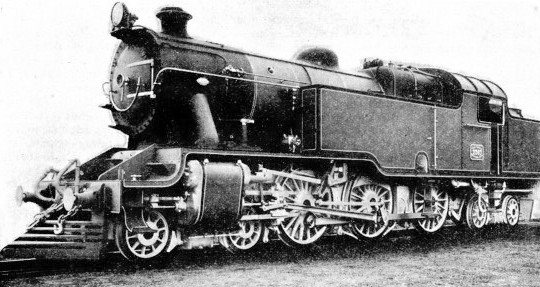
A passenger engine used on the Buenos Aires and Pacific Railway. This 4-
As there are few large towns and holiday resorts on the system the passenger traffic is not heavy. Passenger trains run daily between Buenos Aires and Alberdi (209 miles), Rufino (262 miles), Villa Mercedes (429 miles), Mendoza (661 miles), and San Juan (757 miles). Passenger and mixed trains combine at junctions with the main line trains and serve the outlying districts. Restaurants and sleeping cars are provided on long-
Wine is the most important item of traffic, and is carried either in special wagons of 40 tons capacity or in oak casks. The cereals and maize traffic is heavy, the fine cereals including wheat, linseed, oats, barley, rye, and birdseed. Cattle trains carrying 500 beasts are common; fruit is carried in refrigerator wagons.
600 Locomotives
There are over 600 locomotives, the most powerful passenger engine being of the 4-
The maximum gradient on the main line is 1 in 78, and on branch lines 1 in 50. The principal rails in use are 70 lb, 72·8 lb, 85 lb and 100 lb. Busy sections are laid with 100-

4-
The Cordoba Central Railway has a route mileage of 1,218 of metre-
The main line runs from Buenos Aires to Rosario, Cordoba and Tucuman. Vignoles flat-
From Retiro to Boulogne, thirteen miles, the main line has been doubled. The terminal goods yard has been built on land reclaimed from the river to the north of Retiro Station, and is called the Re tiro Norte yard; it has access to the port. The principal stations are at Retiro, Rosario, Cordoba, Santiago del Estero, and Tucuman. As there is no city in the Argentine comparable with Buenos Aires for size and importance, the traffic on all the railways is more or less in one direction for goods, and on the Cordoba Railway the south-
For the year ended June 30, 1934, goods traffic exceeded 2,029,000 tons.
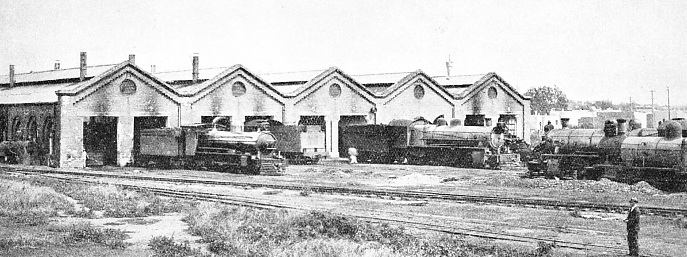
ENGINE SHEDS of the Cordoba Central Railway at Alta Cordoba. Here the Company also has its workshops, where locomotives and rolling stock are kept in repair. The works cover an area of over 123 acres.
You can read more on “British Enterprise in South America”, “Main Lines of Brazil” and “The Trains of Uruguay” on this website.